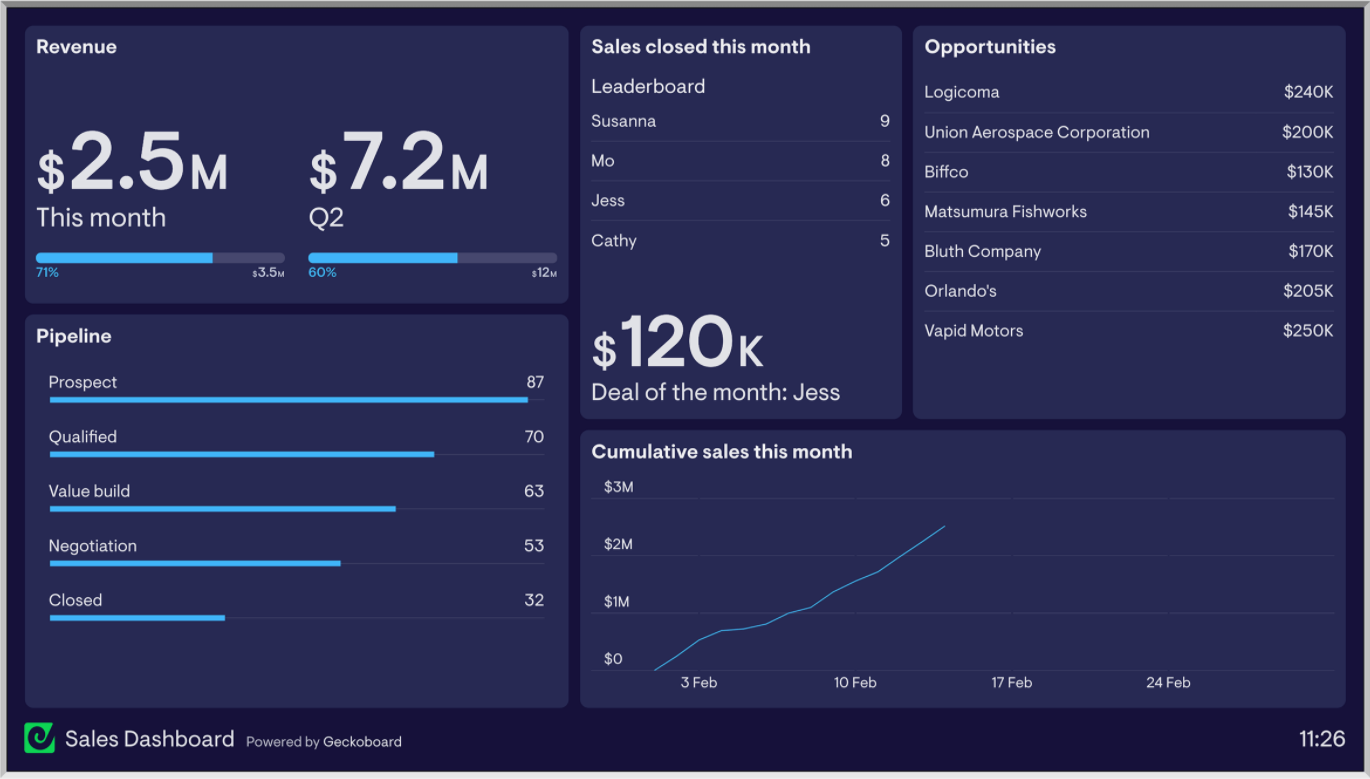When Jason Marsdale joined Monroe, a commercial calculator company, as a senior sales and marketing manager, he quickly realized what was missing: a clearly defined way to track progress toward sales goals. He defined specific sales key performance indicators (KPIs) and implemented a way to monitor them. As a result, Marsdale was able to dramatically increase sales — anywhere from 10-50% per rep.
Your sales team needs a defined set of metrics. It helps them (and you) monitor progress and identify areas for improvement. But with dozens of potential metrics to choose from, it can be challenging to know where to start.
But don’t worry — defining sales KPIs is less daunting than it might seem. We put together a few simple steps you can follow to select metrics that are directly related to your sales goals. We’ve also included a list of common sales KPIs you can use as inspiration.
Define company-wide and team-specific goals
Before you can choose sales KPIs, first you have to define specific objectives. Start by outlining company-wide revenue and growth goals. Some examples might include:
- Increase annual revenue to X amount.
- Acquire X new customers in the next year.
- Increase gross profit margin by X%.
Typically, companies have one primary objective, with one or two secondary goals that provide context and support the primary objective. If your main goal is increasing annual revenue to a certain amount, a secondary goal would be to increase revenue by X% each month.
Once you’ve identified company-wide goals, work with your sales reps to develop team and individual objectives that will help the business reach its broader goals.
To help increase the company’s annual revenue, there are a few team- or rep-specific goals you could set:
- Increase the number of closed deals by X% month-over-month.
- Decrease average sales cycle length by X%.
- Increase marketing qualified lead (MQL) to sales qualified lead (SQL) conversion rate.
Set primary sales goals(e.g., total monthly sales) that are directly related to your industry. Ecommerce businesses track progress based on individual purchases and a higher number of customers, while SaaS businesses are focused on recurring revenue.
Identify specific actions to help you reach each goal
After outlining broad goals, determine what individual or team actions need to happen to make that goal a reality. If your objective is to increase revenue, define the key activities that drive revenue growth. From there, you can select KPIs that inspire action and monitor progress toward your revenue goal.
Start with the goal and work backward. How many deals do you need to close to hit your target revenue? Based on that number and your average lead-to-customer conversion rate, how many opportunities should be in your pipeline? From there, you can start to figure out the numbers of calls, emails, or meetings your sales team needs per month and how many leads or contacts your marketing team needs to generate to hit your objective.
Here are some examples of actions you might assign your sales team, depending on your objective:
- Send X outreach emails per day/month.
- Make X calls to leads per day/month.
- Follow up with leads a maximum of X days after first contact.
Identifying actions before choosing sales KPIs helps narrow down which metrics are best for measuring how your team works toward their goals.
Determine the best way to measure progress for every action
Now you’re ready to select your sales KPIs. For each action or goal, choose the metric that offers the most insight into your progress. A KPI should be something you can measure on a daily or monthly basis and use to inform business decisions.
KPIs should be fairly obvious for the actions you’ve identified for your sales team. If the action is “make X calls per day,” for example, your KPI would be “number of calls made per day.”
Consider setting contextual KPIs to show how your current progress compares to your overall goal. If your objective is to increase revenue, a contextual KPI would be “monthly sales ($) to date vs. target monthly sales ($).”
When a KPI shows you aren’t meeting your goal, it also tells you what you need to do next. If the number of sales calls per day is below your goal, you know you need to meet with your sales team or with individual reps to find out why call numbers are low and plan a course of action.
10 sales KPI examples to get you started
While we can’t tell you exactly which sales KPIs are right for your team, we put together a list of common sales metrics to help set you on the right track.
- Activity per rep: The average number of calls, emails, or other outreach activities performed by each sales rep over a set period, such as daily or monthly. You can narrow this metric further and look specifically at calls per rep, emails per rep, or meetings per rep, depending on which activity has the best conversion rates for your business
- Average follow-up attempts: The average number of times a sales rep tries to contact a lead before giving up on the lead
- Average sales cycle length: The average amount of time between the first contact with a lead and when they become a customer
- Customer acquisition cost: How much it costs in sales and marketing tactics to acquire one new customer. Compare this to customer lifetime value to see if you might need to adjust pricing or reduce sales costs
- Lead response time: Average time it takes for a sales rep to follow up with a potential lead. This metric is typically for self-identified leads, such as people who submit a form or download an ebook
- MQL to SQL conversion rate: The percentage of marketing qualified leads who move down the funnel to become sales qualified leads
- SQL to Win Conversion Rate: The number of SQLs who become paying customers
- Number of deals closed: The number of deals your sales team closes in a certain time frame, such as weekly or monthly. Compare it to your goal number of deals to more accurately gauge your progress. You can also track this metric for individual sales reps
- Pipeline volume vs. goal: The total number of leads currently in your sales pipeline compared to your target number of leads
- Revenue growth rate: Your month-over-month percentage increase in revenue
Collect input from your team about which sales KPIs will help them track progress toward their goals and the company’s goals. Use their ideas to build a list of top-priority metrics. This will help ensure that each sales rep knows which KPIs to prioritize, so your whole team is on the same page.
Keep sales KPIs top-of-mind with a dashboard
Defining KPIs doesn’t help your team much if the data is buried in a static document or spreadsheet. KPIs are living metrics that should be shared and monitored regularly.
Work with your team to identify the five to eight most important sales metrics and add them to a data dashboard. Display your data dashboard on an office TV, or share it in Slack or via sharing links.

When your team can check key metrics on a daily basis, they can track progress and prioritize actions. A dashboard also helps sales teams detect changes or potential problems right away and address them before they become major concerns.

